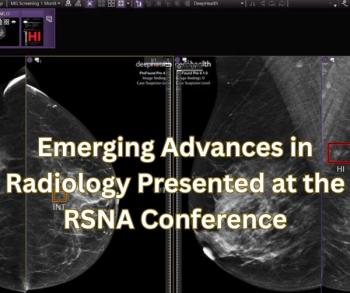
- Diagnostic Imaging Vol 30 No 11
- Volume 30
- Issue 11
Carestream unveils wireless x-ray detector retrofit
Carestream Health may have come up with the ultimate radiography retrofit: a wireless x-ray detector that fits into existing table- and wall-mounted buckys.
Carestream Health may have come up with the ultimate radiography retrofit: a wireless x-ray detector that fits into existing table- and wall-mounted buckys.
The new detector, when tied to an acquisition console and image processing software, promises to instantly upgrade a film-based radiography suite to digital, providing the simplicity of computed radiography and the immediate image acquisition and processing of digital radiography.
"You have the flexibility of a cassette and the throughput of a DR room," said Todd Minnigh, world-wide director of marketing for digital radiography at Carestream Health.
A work-in-progress until its scheduled 2009 commercial debut, the DRX-1 was unveiled in early September with beta tests scheduled to begin later that month at a half-dozen sites around the world. The company plans to begin taking orders in the fourth quarter.
The finished product, priced around $120,000, will consist of a console and a wireless 14 × 17-inch (35 × 43-cm) cassette-sized flat-panel detector. Data will be postprocessed using algorithms already in use on Carestream's Kodak DirectView CR and DR systems.
Preview images will appear on the console in less than five seconds, according to the company. Data will then be transmitted as DICOM files to a PACS or other storage device. The detector itself will have virtually no limitations on its use. It will be compatible with x-ray products found in just about any radiographic setting, including general radiology, trauma, and orthopedics.
The detector is designed to run off a battery powerful enough to handle up to 90 exposures, according to Minnigh. When power runs out, the battery can be swapped for another in a matter of seconds. Alternatively, the detector can be configured with a tether that can be plugged into a power source. But he expects few buyers to select this option.
"As a general rule, I think people are going to like the idea that they can take the detector out of the drawer and, because of the wireless transmitter, take it anywhere in the room to make a picture," Minnigh said.
The detector with battery will weigh just 8.5 pounds, about 30% less than other portable detectors. It will also be about half the size of competing models yet provide the same coverage. The compact and lightweight design allows its easy use in table and wall mounts.
"Competing products typically have handles because they are heavier. They are not in cassette form," he said. "What that means to the customers is that they have to modify their tables to take the detector."
No modifications of installed film-based equipment are needed to use the detector. This paves the way for an easy and cost-efficient upgrade from film to digital, Minnigh said. Costs are further held in check by the inherent portability of the wireless detector, which can be shared among table or wall mounts within a radiography suite. It will also work with off-the-shelf grids and grid holders for tabletop use.
Facilities can use the DR plate as well as film or CR-based cassettes during their transition to digital, Minnigh said. Sites investing in the new system, therefore, can use film and CR products as a backup.
-By Greg Freiherr
Articles in this issue
about 17 years ago
Multicenter trial confirmsvalue of coronary CT angioabout 17 years ago
Siemens tweaks PET/CT T with hybrid for radiologyabout 17 years ago
GE Healthcare seeks better image quality, lower doseabout 17 years ago
Tech advisor CT vendors plot strategies for growthabout 17 years ago
Vendors polish advanced apps with 3T platformsabout 17 years ago
MRI spots anomalies in children with hearing lossabout 17 years ago
CT proves clinical worth in bowel obstruction casesabout 17 years ago
Strategies can limit imaging fungibilityabout 17 years ago
Smart probes and biomarkers spot earliest signs of cancerabout 17 years ago
MRA finds value in hydrocephalus interventionsNewsletter
Stay at the forefront of radiology with the Diagnostic Imaging newsletter, delivering the latest news, clinical insights, and imaging advancements for today’s radiologists.




























